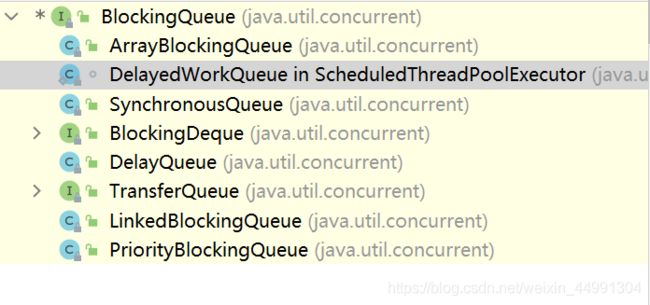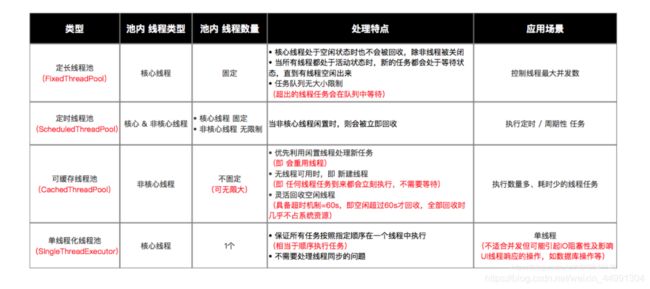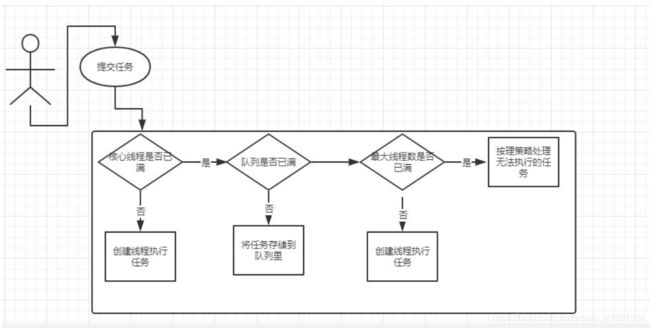全面解析java线程池
什么是线程池
程序运行的本质是cpu进程的调度(占用系统的资源)进程是一个动态的过程,是一个活动的实体。简单来说,一个应用程序的运行就可以被看做是一个进程,而线程,是运行中的实际的任务执行者。可以说,进程中包含了多个可以同时运行的线程。而在Java中,内存资源是极其宝贵的,所以,我们就提出了线程池的概念。
线程池:Java中开辟出了一种管理线程的概念,这个概念叫做线程池,使用池的技术可以降低资源消耗(常见的池技术有jdbc连接池,线程池,内存池,对象池)。线程池的优点有:
(1)降低资源消耗。通过重复利用已创建的线程降低线程创建和销毁造成的消耗。
(2)提高响应速度。当任务到达时,任务可以不需要等到线程创建就能立即执行。
(3)提高线程的可管理性。线程是稀缺资源,如果无限制的创建,不仅会消耗系统资源,还会降低系统的稳定性,使用线程池可以进行统一的分配,调优和监控。
线程的六种状态
NEW:
可运行线程的线程状态。一个处于可运行状态的线程正在Java虚拟机中执行,但它可能正在等待来自操作系统(如处理器)的其他资源。
RUNNABLE:
等待监视器锁而阻塞的线程的线程状态。处于阻塞状态的线程正在等待监视器锁进入一个同步的块/方法,或者在调用之后重新进入一个同步的块/方法。
BLOCKED:
处于等待状态的线程正在等待另一个线程执行特定的操作。例如,在一个对象上调用了object. wait()的线程正在等待另一个线程在该对象上调用object. notify()或object. notifyall()。调用thread .join()的线程正在等待指定的线程终止。
WAITING:
具有指定等待时间的等待线程的线程状态。由于调用了下列方法中的一个,并且指定了正等待时间,线程处于定时等待状态:
Thread.sleep
Object.wait with timeout
Thread.join with timeout
LockSupport.parkNanos
LockSupport.parkUntil
TIMED_WAITING:
终止线程的线程状态。线程已经完成执行。
TERMINATED:
线程终止状态线程被销毁。
四种常见线程池
Executors.newSingleThreadExecutor();//单一线程创建一个线程执行任务
ExecutorService threadPool = Executors.newSingleThreadExecutor();//单一线程
for (int i = 1; i <= 5; i++) {
threadPool.execute(()->{
System.out.println(Thread.currentThread().getName());
});
}
运行结果:
pool-1-thread-1
pool-1-thread-1
pool-1-thread-1
pool-1-thread-1
pool-1-thread-1
特点:只有 1 个核心线程,无非核心线程,执行完立即回收,任务队列为链表结构的有界队列。
应用场景:不适合并发但可能引起 IO 阻塞性及影响 UI 线程响应的操作,如数据库操作、文件操作等。
Executors.newFixedThreadPool(5);//创建一个固定数量的线程池执行任务
ExecutorService executorService = Executors.newFixedThreadPool(5);
for (int i = 1; i <= 5; i++) {
executorService.execute(()->{
System.out.println(Thread.currentThread().getName());
});
}
//关闭线程池
executorService.shutdown();
执行结果:
pool-1-thread-1
pool-1-thread-4
pool-1-thread-3
pool-1-thread-2
pool-1-thread-5
特点:定长的线程池,有核心线程,核心线程的即为最大的线程数量,没有非核心线程。
应用场景:控制线程最大并发数。
Executors.newCachedThreadPool();//遇强则强遇弱则弱
ExecutorService executor = Executors.newCachedThreadPool();
for (int i = 1; i <= 10; i++) {
executor.execute(()->{
System.out.println(Thread.currentThread().getName());
});
}
//关闭线程池
executor.shutdown();
测试结果:
pool-1-thread-1
pool-1-thread-2
pool-1-thread-5
pool-1-thread-4
pool-1-thread-3
pool-1-thread-6
pool-1-thread-9
pool-1-thread-7
pool-1-thread-8
pool-1-thread-10
特点:可缓存的线程池,该线程池中没有核心线程,非核心线程的数量为Integer.max_value,就是无限大,当有需要时创建线程来执行任务,没有需要时回收线程。
应用场景:适用于耗时少,任务量大的情况。
Executors.newScheduledThreadPool
public class demo6 {
public static void main(String[] args) {
ExecutorService executor = Executors.newScheduledThreadPool(3);
for (int i = 1; i <= 9; i++) {
executor.execute(()->{
System.out.println(Thread.currentThread().getName());
});
}
//关闭线程池
executor.shutdown();
//Thread.State
}
}
周期性执行任务的线程池,按照某种特定的计划执行线程中的任务,有核心线程,但也有非核心线程,非核心线程的大小也为无限大。适用于执行周期性的任务。
线程池的七大参数
下面我们来分析一下源代码Executors其实是一个线程池的工具类真正创建线程池的还是ThreadPoolExecutor类下面我们来看看ThreadPoolExecutor类的构造方法:
public ThreadPoolExecutor(int corePoolSize,
int maximumPoolSize,
long keepAliveTime,
TimeUnit unit,
BlockingQueue<Runnable> workQueue) {
this(corePoolSize, maximumPoolSize, keepAliveTime, unit, workQueue,
Executors.defaultThreadFactory(), defaultHandler);
}
public ThreadPoolExecutor(int corePoolSize,
int maximumPoolSize,
long keepAliveTime,
TimeUnit unit,
BlockingQueue<Runnable> workQueue,
ThreadFactory threadFactory) {
this(corePoolSize, maximumPoolSize, keepAliveTime, unit, workQueue,
threadFactory, defaultHandler);
}
public ThreadPoolExecutor(int corePoolSize,
int maximumPoolSize,
long keepAliveTime,
TimeUnit unit,
BlockingQueue<Runnable> workQueue,
RejectedExecutionHandler handler) {
this(corePoolSize, maximumPoolSize, keepAliveTime, unit, workQueue,
Executors.defaultThreadFactory(), handler);
}
public ThreadPoolExecutor(int corePoolSize,
int maximumPoolSize,
long keepAliveTime,
TimeUnit unit,
BlockingQueue<Runnable> workQueue,
ThreadFactory threadFactory,
RejectedExecutionHandler handler) {
if (corePoolSize < 0 ||
maximumPoolSize <= 0 ||
maximumPoolSize < corePoolSize ||
keepAliveTime < 0)
throw new IllegalArgumentException();
if (workQueue == null || threadFactory == null || handler == null)
throw new NullPointerException();
this.corePoolSize = corePoolSize;
this.maximumPoolSize = maximumPoolSize;
this.workQueue = workQueue;
this.keepAliveTime = unit.toNanos(keepAliveTime);
this.threadFactory = threadFactory;
this.handler = handler;
}
从源码中我们发现了构造方法中一共有七个参数
- corePoolSize(必需):核心线程数。默认情况下,核心线程会一直存活,但是当将 allowCoreThreadTimeout 设置为 true 时,核心线程也会超时回收。
- maximumPoolSize(必需):线程池所能容纳的最大线程数。当活跃线
程数达到该数值后,后续的新任务将会阻塞。
3.keepAliveTime(必需):线程闲置超时时长。如果超过该时长,非核心线程就会被回收。如果将allowCoreThreadTimeout 设置为 true 时,核心线程也会超时回收。
4.unit(必需):指定keepAliveTime 参数的时间单位。常用的有:TimeUnit.MILLISECONDS(毫秒)、TimeUnit.SECONDS(秒)、TimeUnit.MINUTES(分)。
5.workQueue(必需):任务队列。通过线程池的 execute() 方法提交的 Runnable 对象将存储在该参数中。其采用阻塞队列实现。
任务队列是基于阻塞队列实现的,即采用生产者消费者模式,在 Java 中需要实现 BlockingQueue 接口。

ArrayBlockingQueue:一个由数组结构组成的有界阻塞队列(数组结构可配合指针实现一个环形队列)。
LinkedBlockingQueue: 一个由链表结构组成的有界阻塞队列,在未指明容量时,容量默认为 Integer.MAX_VALUE。
PriorityBlockingQueue: 一个支持优先级排序的无界阻塞队列,对元素没有要求,可以实现 Comparable 接口也可以提供 Comparator 来对队列中的元素进行比较。跟时间没有任何关系,仅仅是按照优先级取任务。
DelayQueue:类似于PriorityBlockingQueue,是二叉堆实现的无界优先级阻塞队列。要求元素都实现 Delayed 接口,通过执行时延从队列中提取任务,时间没到任务取不出来。
SynchronousQueue: 一个不存储元素的阻塞队列,消费者线程调用 take() 方法的时候就会发生阻塞,直到有一个生产者线程生产了一个元素,消费者线程就可以拿到这个元素并返回;生产者线程调用 put() 方法的时候也会发生阻塞,直到有一个消费者线程消费了一个元素,生产者才会返回。
LinkedBlockingDeque: 使用双向队列实现的有界双端阻塞队列。双端意味着可以像普通队列一样 FIFO(先进先出),也可以像栈一样 FILO(先进后出)。
LinkedTransferQueue: 它是ConcurrentLinkedQueue、LinkedBlockingQueue 和 SynchronousQueue 的结合体,但是把它用在 ThreadPoolExecutor 中,和 LinkedBlockingQueue 行为一致,但是是无界的阻塞队列。

注意有界队列和无界队列的区别:如果使用有界队列,当队列饱和时并超过最大线程数时就会执行拒绝策略;而如果使用无界队列,因为任务队列永远都可以添加任务,所以设置 maximumPoolSize 没有任何意义。
6.threadFactory(可选):线程工厂。用于指定为线程池创建新线程的方式。
7.handler(可选):拒绝策略。当达到最大线程数时需要执行的饱和策略。拒绝策略我们在下面讲
下面依靠一张图来更好的理解线程池和这几个参数

由图,我们可以看出,线程池中的corePoolSize就是线程池中的核心线程数量,这几个核心线程,就算在没有用的时候,也不会被回收,maximumPoolSize就是线程池中可以容纳的最大线程的数量,而keepAliveTime,就是线程池中除了核心线程之外的其他的最长可以保留的时间,因为在线程池中,除了核心线程即使在无任务的情况下也不能被清除,其余的都是有存活时间的,意思就是非核心线程可以保留的最长的空闲时间,而unit,就是计算这个时间的一个单位,workQueue,就是等待队列,任务可以储存在任务队列中等待被执行,执行的是FIFIO原则(先进先出)。threadFactory,就是创建线程的线程工厂,最后一个handler,是一种拒绝策略,我们可以在任务满了之后,拒绝执行某些任务。
线程池的处理流程
四种拒绝策略
当线程池的线程数达到最大线程数时,需要执行拒绝策略。拒绝策略需要实现 RejectedExecutionHandler 接口,并实现 rejectedExecution(Runnable r, ThreadPoolExecutor executor) 方法。不过 Executors 框架已经为我们实现了 4 种拒绝策略:
AbortPolicy(默认):丢弃任务并抛出 RejectedExecutionException 异常。
public class demo2 {
public static void main(String[] args) {
//创建一个核心线程为2,最大容量线程为5线程闲置超时时长为3秒,采取拒绝策略的线程池
ThreadPoolExecutor poolExecutor = new ThreadPoolExecutor(2, 5, 3, TimeUnit.SECONDS,
new ArrayBlockingQueue<>(3), Executors.defaultThreadFactory(),
new ThreadPoolExecutor.AbortPolicy());
//最大承载=最大容量线程+队列数量=8
//9>8超过最大承重量报RejectedExecutionException
for (int i = 0; i < 9; i++) {
poolExecutor.execute(()->{
System.out.println(Thread.currentThread().getName());
});
}
}
}
测试结果:
pool-1-thread-1
pool-1-thread-3
pool-1-thread-2
pool-1-thread-4
pool-1-thread-3
pool-1-thread-1
pool-1-thread-5
pool-1-thread-2
Exception in thread "main" java.util.concurrent.RejectedExecutionException: Task threadpool.demo2$$Lambda$14/0x0000000100066840@71be98f5 rejected from java.util.concurrent.ThreadPoolExecutor@6fadae5d[Running, pool size = 5, active threads = 5, queued tasks = 0, completed tasks = 3]
at java.base/java.util.concurrent.ThreadPoolExecutor$AbortPolicy.rejectedExecution(ThreadPoolExecutor.java:2055)
at java.base/java.util.concurrent.ThreadPoolExecutor.reject(ThreadPoolExecutor.java:825)
at java.base/java.util.concurrent.ThreadPoolExecutor.execute(ThreadPoolExecutor.java:1355)
at threadpool.demo2.main(demo2.java:16)
CallerRunsPolicy:由调用线程处理该任务。
public class demo3 {
public static void main(String[] args) {
//创建一个核心线程为2,最大容量线程为5线程闲置超时时长为3秒
ThreadPoolExecutor poolExecutor = new ThreadPoolExecutor(2, 5, 3, TimeUnit.SECONDS,
new ArrayBlockingQueue<>(3), Executors.defaultThreadFactory(),
new ThreadPoolExecutor.CallerRunsPolicy());
//最大承载=最大容量线程+队列数量
//超过报RejectedExecutionException
for (int i = 0; i < 9; i++) {
poolExecutor.execute(()->{
System.out.println(Thread.currentThread().getName());
});
}
}
}
超过了由主线程来处理
pool-1-thread-1
pool-1-thread-3
main
pool-1-thread-2
pool-1-thread-2
pool-1-thread-2
pool-1-thread-2
pool-1-thread-4
pool-1-thread-5
DiscardPolicy:丢弃任务,但是不抛出异常。可以配合这种模式进行自定义的处理方式。
public class demo4 {
public static void main(String[] args) {
//创建一个核心线程为2,最大容量线程为5线程闲置超时时长为3秒
ThreadPoolExecutor poolExecutor = new ThreadPoolExecutor(2, 5, 3, TimeUnit.SECONDS,
new ArrayBlockingQueue<>(3), Executors.defaultThreadFactory(),
new ThreadPoolExecutor.DiscardPolicy());
//最大承载=最大容量线程+队列数量
//超过报RejectedExecutionException
for (int i = 0; i < 9; i++) {
poolExecutor.execute(()->{
System.out.println(Thread.currentThread().getName());
});
}
}
}
丢掉了一个任务
pool-1-thread-1
pool-1-thread-3
pool-1-thread-2
pool-1-thread-4
pool-1-thread-3
pool-1-thread-1
pool-1-thread-5
pool-1-thread-2
DiscardOldestPolicy:丢弃队列最早的未处理任务,然后重新尝试执行任务。优化版
public class demo5 {
public static void main(String[] args) {
//创建一个核心线程为2,最大容量线程为5线程闲置超时时长为3秒,采取拒绝策略的线程池
ThreadPoolExecutor poolExecutor = new ThreadPoolExecutor(2, 5, 3, TimeUnit.SECONDS,
new ArrayBlockingQueue<>(3), Executors.defaultThreadFactory(),
new ThreadPoolExecutor.DiscardOldestPolicy());
//最大承载=最大容量线程+队列数量
//超过报RejectedExecutionException
for (int i = 0; i < 12; i++) {
poolExecutor.execute(()->{
System.out.println(Thread.currentThread().getName());
});
}
}
}
pool-1-thread-1
pool-1-thread-3
pool-1-thread-3
pool-1-thread-3
pool-1-thread-2
pool-1-thread-1
pool-1-thread-4
pool-1-thread-5
总结
Executors 的 4 个功能线程池虽然方便,但现在已经不建议使用了,而是建议直接通过使用 ThreadPoolExecutor 的方式,这样的处理方式让写的同学更加明确线程池的运行规则,规避资源耗尽的风险。
其中 Executors 的功能线程有如下弊端:
FixedThreadPool 和 SingleThreadExecutor:主要问题是堆积的请求处理队列均采用 LinkedBlockingQueue,可能会耗费非常大的内存,甚至 OOM。
CachedThreadPool:主要问题是线程数最大数是Integer.MAX_VALUE,可能会创建数量非常多的线程,甚至 OOM。

